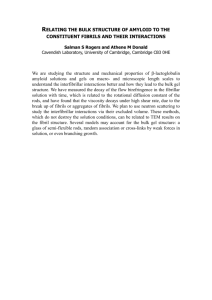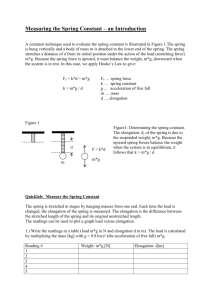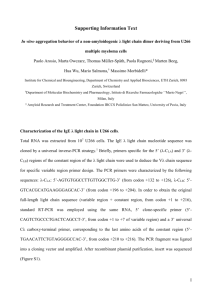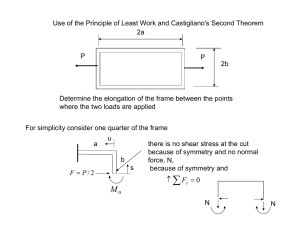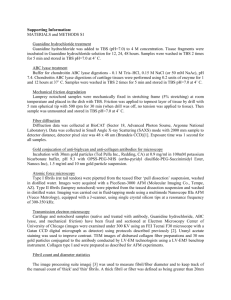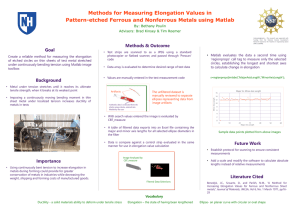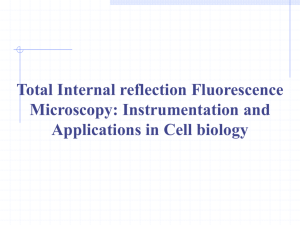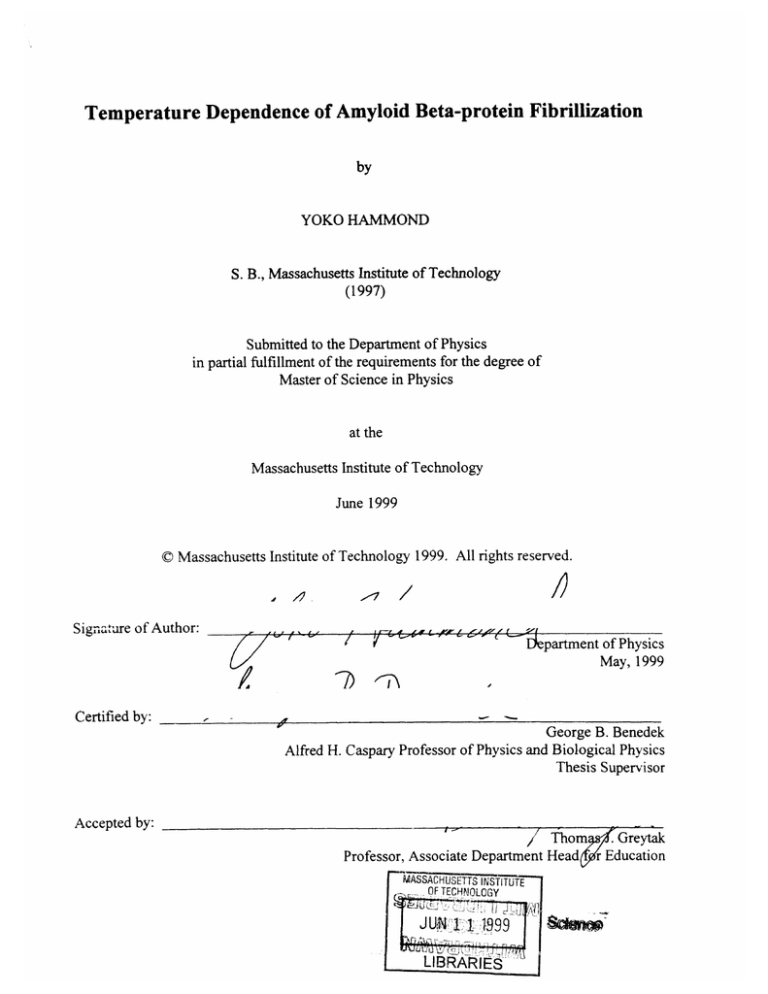
Temperature Dependence of Amyloid Beta-protein Fibrillization
by
YOKO HAMMOND
S. B., Massachusetts Institute of Technology
(1997)
Submitted to the Department of Physics
in partial fulfillment of the requirements for the degree of
Master of Science in Physics
at the
Massachusetts Institute of Technology
June 1999
C Massachusetts Institute of Technology 1999. All rights reserved.
Signa*ure of Author:
department of Physics
May, 1999
Certified by:
George B. Benedek
Alfred H. Caspary Professor of Physics and Biological Physics
Thesis Supervisor
Accepted by:
Thoma
Professor, Associate Department Head
MASSACHUSEETTS INSTITUTE
OF TECHNOLOGY
"a
JU I
~9
LIBRARIES
. Greytak
Education
Temperature Dependence of Amyloid Beta-protein Fibrillization
by
Yoko Hammond
Submitted to the Department of Physics
on May 7, 1999 in partial fulfillment of the
requirements for the Degree of
Master of Science in Physics
Abstract
This thesis presents my study of AP fibrillogenesis in two parts. In Part 1, I review the research
process that was undertaken and what I learned from it. In Part 2 of the paper I present, in the
form of a reprint , the scientific finished product of this investigation which was published in
PNAS and for which I am the first author. Part 2 of this thesis reports, in greater detail, the siudy
of the temperature dependence of the AP fibril elongation rate constant, ke, in 0.1 M HCl. The
rate of fibril elongation was measured at AP monomer concentrations ranging from 50 to 400
p.M and at temperatures from 40 C to 40*C. Over this temperature range, k, increases by two
The temperature dependence of k, follows the Arrhenius law,
orders of magnitude.
The pre-exponential factor A and the activation energy, EA are
ke = A exp(- EA / kT).
~~6 x 101" liter / (mol -sec) and 23 kcal/mol, respectively. Such a high value of E, suggests that
significant conformational changes are associated with the binding of AP monomers to fibril
ends.
Thesis Supervisor: George B. Benedek
Title: Alfred H. Caspary Professor of Physics and Biological Physics
o my 4aLian]
wo
L 1r/V
opened my eyei
Introduction
This thesis presents my study of AP fibrillogenesis in two parts. In Part 1, I review the
research process that was undertaken and what I learned from it. In Part 2 of the paper I present,
in the form of a reprint , the scientific finished product of this investigation which was published
in PNAS and for which I am the first author.
In Part 1, the discussion of the research process and what I learned from it, I first present
the genesis of the literature search. Next, I discuss the experimental procedure, which includes
an outline of how samples were prepared and data was collected. Then, in the Data Analysis
section, I discuss how the data were analyzed using constrained regularization method. In the
final section of Part 1, I discuss how the results of the analysis were interpreted. In Part 2, the
reprint, I present the final scientific product.
4
PART 1: Research Process
Literature Search
I began the research process by conducting literature review. After reading Dr. Lomakin's
paper (Lomakin, A. et. al. (1996) PNAS 93, 1125-1129), I reviewed the references and used that
as the basis of a more extensive search. In addition, I gathered other information on Alzheimer's
disease (AD) and its effect on the U. S. society.
The literature reports that AD is the most common cause of dementia and the fourth
leading cause of death in the United States. Nearly four million people are believed to be
afflicted with the disease. The costs associated with the care of those afflicted is estimated to be
$136 billion in the United States alone.
Current treatments only ease symptoms, providing
neither a cure nor effectively retarding the progression of the disease.
Research published has identified a characteristic feature of AD patients to be the
presence of amyloid plaques in their brain.
Findings show that the principal constituent of
amyloid plaques are amyloid P-protein (AP) fibrils. Pathological studies of AD brains, for
example one performed by Yankner, show that neurodegenerative changes occur around compact
plaques composed of AP fibrils (Yankner, B. A. (1996) Neuron 16, 921-932). Furthermore, it
has also been demonstrated that AP fibrils are neurotoxic in vitro.
Other findings suggest that AP fibril formation requires the presence of a nucleus. While
research findings are not conclusive regarding the antecedent factors that lead to the formation of
5
PART 1: Research Process
nuclei, more conclusive finding exist regarding the growth of Ap fibrils. For example, Naiki has
found that elongation of fibrils is characteristic of first-order kinetics (Naiki, H. & Nakakuki, K.
(1996) Lab. Invest. 74, 374-383).
Quasielastic Light Scattering Spectroscopy (QLS) was used to monitor AP fibril
formation. It is an optical method for quantitatively determining the diffusion coefficients of
particles undergoing Brownian motion in solution (Pecora, R. (1985) Dynamic Light Scattering,
Plenum Press, New York, NY). Sample solutions are placed in the QLS apparatus between a
laser light source and a detector. Scattered light collected by the detector is a sum of scattered
light from individual particles in the sample solution. The relative positions of particles within
the scattering volume determine the phase difference of scattered waves from each particle.
Brownian motion of the scattering particles change the phase differences for all pairs of scattered
waves and as a result, the intensity of the scattered light detected becomes uncorrelated to its
initial intensity. The correlation time is determined by the diffusion coefficient of scattering
particles, rc ~ 1/Dq
2
, where D is the diffusion coefficient and q is the scattering vector. Thus,
by measuring the temporal correlation of the fluctuating light signal, diffusion coefficients of
scattering particles in the sample solution can be determined.
QLS measures the diffusion coefficient of individual scattering particles.
From the
diffusion coefficient, one can calculate the hydrodynamic radius of each particle using the
Stokes-Einstein relation D = kB T/61rqR, , where kB is Boltzmann's constant, T is the absolute
temperature, and q is the solvent viscosity. Thus, it is advantageous to use QLS, rather than
6
PART 1: Research Process
turbidity or Fourier-transform IR spectroscopy, because it allows for the measurement of
individual fibril size.
The peptide solution environment was chosen to be at pH=l. There are both advantages
and disadvantages to setting the pH level to pH=l rather than to the physiological pH. On the
one hand, an advantage to setting pH=1 is that at this condition, fibril elongation rate slows down
sufficiently to enable detailed monitoring of the entire fibril formation process by QLS,
particularly the initial, faster elongation stage of the process.
Previous QLS experiments
performed at neutral pH have only been able to provide data on later stages of AD fibril
formation. Another advantage of this condition is that it eliminates fibril-to-fibril association, a
form of aggregation which makes the interpretation of QLS data more difficult. On the other
hand, one of the disadvantage of performing experiments at pH=l is that Ap protein may take
conformation different from that at physiological pH. Different conformation may lead to fibril
morphology different from that found in vivo Another possible disadvantage is that the
fibrillogenesis mechanism might operate differently at pH=1 than at physiological pH. However,
as Dr. Lomakin reported (Lomakin, A. et.al. (1996) PNAS 93, 1125-1129), AD fibrils formed
under this condition were structurally indistinguishable from those observed in the brains of AD
patients. On this basis, one may expect that the mechanisms of A@ fibril elongation at pH=1 are
the same as those operating at the physiological pH level.
Experimental Procedure
The goal of this research was to use Quasielastic Light Scattering to determine the
activation energy of the binding of Ap to the growing fibril tip and to understand the molecular
7
PART 1: Research Process
mechanism of elongation. As mentioned earlier, AP fibril elongation follows first-order kinetics;
thus, the elongation rate k, is described by the Arrhenius law, k, = A exp(- EA / kT), where E is
the activation energy, A is the prefactor, k is Boltzmann's constant, and T is the absolute
temperature.
Therefore, to generate plots of k, versus
/T, I used QLS to measure ke by
monitoring the rate of fibril elongation at various temperatures.
The primary procedure consisted of preparing sample of varying concentrations of AP
solution and performing QLS measurements of the fibril elongation rate in each sample. Two
sets of samples were prepared:
one at high concentrations of AP and the other at low
concentrations. High concentration samples were prepared by adding 0. IN HCl to lyophilized
AB to achieve the desired peptide concentration. Next, I vortexed the mixture for approximately
5 seconds, subsequently filtering or sedimenting large aggregates. To filter the solution, I used
an Anotop 10 Plus 20 nm inorganic filter to remove large aggregates from the sample.
Alternatively, I centrifuged the solution at 20,000 x g for 30 minutes to sediment aggregates. The
latter procedure was adopted to reduce the amount of AB peptide loss during the filtration
process. In either case, after removing large aggregates, I aliquotted the solution into two clean
test tubes to take QLS measurements.
At high concentrations (above the critical micellar concentration c), as Dr. Lomakin
reported, AP monomers form micelles (Lomakin, A. et.al. (1996)
PNAS
93, 1125-1129).
Nuclei, which are required for AP fibril elongation, form out of these micelles.
At low
concentrations (below c'), however, alternative nucleation pathways predominates in the
absence of AP micelles. Alternative nucleation, which includes, but is not limited to nucleation
8
PART 1: Research Process
on impurities, is not controllable. Therefore the sample preparation procedure outlined above
proved ineffective when preparing low concentration samples. When low concentration samples
were prepared in the way described above, I was unable to observe nucleation or subsequent
fibril elongation; consequently, an alternative sample preparation procedure had to be developed.
After exploring the issue with Dr. Lomakin, I prepared low concentration AP sample solutions
using the following, pre-incubation method.
First, I prepared a high concentration A$ sample solution, as in the procedure described
above. Then I incubated the solution at room temperature, monitoring the fibril growth of AP
using QLS. After about four hours, short fibrils formed from these nuclei created from micelles.
I then took the solution out of the QLS apparatus and diluted it to the desired concentration. The
diluted, low concentration, sample was then aliquotted into four test tubes. The samples were
then divided; I took two samples for immediate QLS measurements, the others I froze at -85'C. I
measured the mean diffusion coefficient of each sample over time at various temperatures. For
example, in the first set of measurements, one sample was measure at 40 C and another was
measured at 25 0 C. Once the first set of measurements were complete, the remaining two frozen
samples were thawed and measured at 15C and 35 0 C.
There are two QLS experimental setups available, thus I was able to make measurements
of two sample solutions concurrently.
For high concentration samples, I took QLS
measurements at 40 C and room temperature (25 0 C). For lower concentration samples I took
measurements at 4'C, 15 0 C, 25*C and 35*C. Low concentration samples, prepared by diluting
high concentration ones, required less peptide and thus could be prepared in greater number.
Consequently, I was able to perform a greater number of measurements at lower concentration.
9
PART 1: Research Process
Given the greater number of samples at lower concentration, I was able to gain greater resolution
of the effect of temperature dependence of the elongation rate per concentration level.
During QLS measurements, I used a Coherent Innova 90 argon laser (514 nm) (Coherent,
Santa Clara, CA). An argon laser was chosen because of its high signal-to-noise ratio; thus
allowing me more accurately observe initial growth rates. I set the scattering angle at 900, and
controlled the temperature by using a water bath and a temperature control unit.
The
autocorrelator used was a 144-channel Langley Ford model 1097 (Amherst, MA).
Analysis
Once the data from QLS measurements were collected, they were analyzed in three steps.
First, I used a regularization program, developed by Dr. Lomakin, and data obtained from QLS
measurements to obtain temporal evolution of the mean hydrodynamic radius.
Second, I plotted the mean hydrodynamic radius vs. time. This plot showed that the rate
of fibril formation was constant initially, then decreased approaching a final fibril length. I used
the interpolation formula for stiff rods with diameter 8 nm to calculate the average fibril length L
from Rh, as discussed later in PART 2. I then determined the total number of monomers in the
fibril according to Nf = AL, where A is the linear density of A P within the fibril (A = 1.6 nm').
I thus determined the elongation rate dNf
/dt
= k, c from the slope of the initial linear domain of
the curve of Rh vs. time
Finally, I plotted the elongation rate kec against the inverse of absolute temperature for
each sample concentration.
Since the elongation kinetics of AP fibrils is of first order, the
10
PART 1: Research Process
elongation rate obeys the Arrhenius law, k, = A exp(- EA / kT), where EA is the activation
energy. Thus, the slope and intercept of a line fitted to the above mentioned data yielded the
activation energy EA and the prefactor A , respectively. I calculated the activation energy to be
EA
= 23 kcal / mol and the prefactor to be A ~ 6 x 101" liter /(mol -sec).
Interpretation of Data/Results
As will be discussed in PART 2, the activation entropy AS associated with the binding of
AP to the growing fibril tip is can be determined. Using the transition state theory and the
thermodynamic relationship AG = E - TAS , the activation entropy can be related to the
prefactor A as AS = R ln(A/v" D). Using the values for the prefactor and the activation energy
obtained, I calculated the entropy associated with the activation process and the free energy of the
activation to be TAS = 16 kcal/mol (at 300 K) and AG = 7 kcal / mol, respectively.
While discussing with Dr. Lomakin the results of our analysis and how they might be
interpreted, it was hypothesized that a significant conformational change, such as protein
unfolding, may be associated with the activation process of AP fibril elongation. This hypothesis
led me to conduct an additional literature review on protein folding. Based on the results from
this review of the literature, it seems reasonable to assume that protein unfolding is a possible
mechanism of the conformational change. The complete discussion is found in the reprint of the
paper attached in the next section.
Through this research process, I learned several experimental methods, such as QLS,
HPLC, and EM, that are particularly useful in studying proteins. I also learned how scientific
I1
PART 1: Research Process
research is conducted, from identifying a problem and developing a strategy to presenting results
in a form of a manuscript and subsequently identifying a new problem based on the results
obtained. Most importantly, it has trained me to approach a problem with a critical mind. I
believe that this research project has greatly helped me develop as a scientist.
12
PART 2: Reprint of PNAS (1998) 95, 12277-12282.
Temperature Dependence of amyloid P-protein fibrillization
Yoko Kusumoto, Aleksey Lomakin, David B. Teplow, and George B. Benedek
Dept. of Physics and Center for Materials Science and Engineering, MIT, Cambridge, MA 02139
Center for Neurologic Diseases, Brigham and Women's Hospital, Boston, MA 02115
Introduction
Alzheimer's disease (AD) is the most common cause of dementia and the fourth leading
cause of death in the United StatesI. AD is characterized by the deposition of the 40 to 42residue amyloid f-protein (AP) in the cerebral parenchyma and vasculature and by the formation
of intracellular neurofibrillary tangles 2 . Two major types of deposit are distinguished, on the
basis of the presence or absence of fibrillar AP aggregates 2.Those deposits containing fibrillar
elements are associated with areas of damaged neuropil, whereas afibrillar deposits are found
within otherwise normal tissue 3. In vitro, fibrillar forms of AP are toxic to neuronal cells 3 4 . The
deposition of fibrillar AP is thus thought to be a seminal event in the pathogenesis of AD 5 . An
increasing body of genetic evidence supports this conclusion6 . In particular, mutations that
increase the overall production of AP, that increase the relative amount of the particularly
13
PART 2: Reprint from PNAS (1998) 95, 12277-12282
amyloidogenic 42-residue form of the peptide, or that facilitate AD deposition have been found to
cause familial forms of AD.
The central role of fibrillar A$ in AD pathogenesis suggests that therapeutic approaches
focused on the fibrillogenesis process would be highly promising. Detailed knowledge of the
mechanism of A
fibrillogenesis helps to identify specific steps in the fibrillogenesis process to
which a drug might be targeted. This knowledge, together with information on the production of
AD monomers and the kinetics of A
fibril degradation, is also needed to foresee the
consequences of intervention at a particular stage of fibrillogenesis. These considerations have
stimulated active investigations of the kinetics of As fibrillization.
In vitro studies have suggested that Ap fibrillogenesis occurs in two distinct stages,
nucleation and elongation of fibers 7. The nucleation stage is a series of thermodynamically
unfavorable steps leading to the creation of a stable nucleus. It is not clear at present how big the
nucleus is. The smallest particles detected in the fibrillogenesis process at low pH have sizes that
correspond to the diameter of an Ap fibril 8 . This finding is consistent with the view that nuclei
are very short fibrils. Heterogeneous nucleation, e.g., on non-Ap seeds, may also occur, which is
a plausible mechanism for the nucleation of A
fibrils in vivo.
In vitro, preexisting
heterogeneous nuclei or AD seeds present a serious experimental problem. The length that fibrils
reach when all soluble peptide is exhausted is inversely proportional to the total number of
nucleated or preexisting fibrils.
In turn, the length of the fibrils is the key parameter that
determines the kinetics of fibril-to-fibril aggregation, or sedimentation of fibril aggregates, or
gelation of the solution.
Thus, lack of control of the number of seeds leads to poor
14
PART 2: Reprint from PNAS (1998) 95, 12277-12282
reproducibility, both in fibrillogenesis kinetics and in the macroscopic properties of the
aggregated AP sample.
Elongation of an individual fibril, however, is a well defined process that is insensitive to
variation in nucleus or seed concentration. There is significant experimental evidence that the
kinetics of the elongation process is of the first order, i.e., AP monomers bind to fibril ends with
8,9,10.
a rate proportional to their concentration c''
dNf =
dt
keC.
(1)
Here, NJ is the number of monomers in a fibril. The proportionality coefficient relating the
elongation rate dNf
constant, ke.
/dt
to the concentration of AP monomers is termed the elongation rate
For the sake of simplicity, the term "monomer" is used to describe the soluble
form of AP that adds to fibril ends. It has been assumed in the past that soluble, nonfibrillar AP
was monomeric; however, the possibility exists that soluble AP is actually dimeric"
.
The elongation rate constant is a fundamental characteristic of the fibrillogenesis process.
It varies with solution conditions such as pH, ionic strength, and temperature and can be altered
by chemical reagents capable of binding to the AP monomer itself or to a fibril end. Quantitative
determination of the effects of fibrillogenesis conditions on ke provides valuable leads to
understanding the molecular mechanism of fibril elongation.
Several methods have been used to study the kinetics of AP fibrillogenesis. The simplest
method, turbidimetry, monitors the total light scattering from the sample' 3" 4 . The intensity of
scattered light grows proportionally to the molecular weight of the scattering particles and ideally
15
PART 2: Reprint from PNAS (1998) 95, 12277-12282
would reflect fibril elongation. In practice, however, the bulk of the scattering intensity arises
from fibril-to-fibril association.
The kinetics of fibril association depends on fibril size,
concentration, and whether the sample is stirred. These factors make quantitative interpretation
of turbidimetry results extremely difficult, if not impossible.
Naiki et al.9 have used thioflavine T binding to study the kinetics of AP fibril elongation.
This method measures the total concentration of fibrillar AP, which increases at the rate kecN,
where N is number concentration of fibrils.
Because N is unknown, it is impossible to
determine the value of ke. However, by comparing samples of identical concentration, seeded
with the same number of fibrils, Naiki et al. were able to study relative temperature and pH
dependencies of k, 9, as well as the effect of apolipoprotein E on the elongation rate 5 .
Quasielastic light scattering (QLS), in contrast, allows the simultaneous, noninvasive
monitoring of both size and molecular weight of particles in solution and is particularly well
suited for studying protein aggregation phenomena1 6 . This method has been used successfully to
study the late stages of fibrillogenesis and the effect of sample preparation procedures on the
fibrillization process 17,1.
The principal difficulty in using QLS is the same as for the less
sophisticated turbidimetry method: fibril-to-fibril association can lead to the formation of large
aggregates, which dominate the light scattering and complicate data interpretation.
In our
previous study8 , we discovered that fibrillization of AP in 0.1 M HCI is highly reproducible, is
free from fibril-to-fibril association, and yields fibrils that are morphologically indistinguishable
from those formed in vivo. QLS was used to monitor both nucleation and elongation of AP
fibrils and to determine quantitatively the elongation and nucleation rate constants. These studies
16
PART 2: Reprint from PNAS (1998) 95, 12277-12282
lead to development of a full mathematical description of the fibrillogenesis process. 19 In this
publication, we present our study of the temperature dependence of the elongation rate of AP
fibrils in 0.1 M HCl and report the activation energy required for the binding of AP monomers to
fibril ends.
Materials and Methods
Protein Preparation. Peptide synthesis, purification, and characterization have been described
previously"'.
Briefly, A3(1-40) was made on an automated peptide synthesizer (Applied
Biosystems model 430A) using 9-fluorenylmethoxycarbonyl-based methods.
Reverse-phase
high-performance liquid chromatography was used for peptide purification. Quantitative amino
acid analysis and matrix-assisted laser desorption/ionization time-of-flight mass spectrometry
yielded the expected composition and molecular weight. The purified peptide was stored as a
lyophilizate at -20'C.
Experimental Protocol.
We first conducted experiments to establish that the temperature
dependence of elongation rates follows the Arrhenius law. AP was dissolved in 0.1 M HCl
(pH=1) at 4*C to a nominal concentration of 250 jiM, vortexed gently, and filtered through a 20nm inorganic membrane filter (Anotop 10 Plus, Whatman) into a QLS cuvette. The sample was
then incubated for 4 hr at 25*C. As reported previously 8 , at this concentration, AP monomers
form micelle-like structures that serve as centers of nucleation. The sample was monitored by
QLS, and, after 4 hr, when fibrils were ~ 120 nm long (hydrodynamic radius Rh ~ 20 nm), was
diluted 5-fold and aliquotted equally among four new cuvettes.
17
One cuvette was used for
PART 2: Reprint from PNAS (1998) 95, 12277-12282
monitoring fibrillogenesis at the highest temperature (35*C), while the other three were frozen
and kept at -85*C.
Preliminary experiments showed no detectable alteration in the course of
fibrillogenesis in samples that had been frozen and thawed. After the fibrillization process in the
first sample was complete, each of the remaining aliquots was thawed sequentially and the time
dependence of fibril size was monitored at 25*C, 15 0 C, and 4'C.
This procedure ensured
identical numbers of fibrils as well as identical total AP concentration in each aliquot. However,
before the incubation at each temperature, there was already considerable elongation of fibrils.
Such significant growth diminished the accuracy with which the value of the elongation rate
could be measured. To improve this accuracy, we performed a series of experiments in which
samples were monitored at different temperatures immediately upon dissolution. Lyophilized
peptide was dissolved and filtered as above, then split into halves. The fibrillogenesis in the
aliquots was then monitored concurrently in two separate spectrometers held at two different
temperatures, typically 40C and 25*C. Such concurrent measurements of fibrillogenesis at two
different temperatures were performed at nominal concentrations of 100, 125, 250, and 375 pM.
The 125 iM sample was centrifuged at 20,000 x g for 30 min rather than being filtered.
In each experiment, when fibrillogenesis was complete, the total AP concentration was
determined by amino acid analysis.
These final concentrations were less, sometimes
significantly less, than the nominal concentration that was calculated from the weight of the
initially dissolved material. Part of the loss was likely because of removal of preexistent fibrils
and aggregates during filtration. As will become clear in the next section, the uncertainty in the
initial concentration of soluble AP is insignificant for the estimation of the thermodynamic
parameters of the binding reaction between AP monomer and fibril end.
18
PART 2: Reprint from PNAS (1998) 95, 12277-12282
QLS and Data Analysis. QLS measurements were performed with a 144-channel Langley Ford
model 1097 correlator (Amherst, MA) and a Coherent Innova 90 argon laser (514 nm)
(Coherent, Santa Clara, CA). The scattering angle was 900. The temperature was controlled by
using an Endocal bath (Neslab Instruments, Portsmouth, NH) and a temperature control unit
with a feedback loop for fine-tuning.
A constrained regularization method was used to determine the mean diffusion
coefficient, D
. The mean hydrodynamic radius R, was calculated using the Stokes-Einstein
relation D = kB T/61cqRh , where kB is Boltzmann's constant, T is the absolute temperature, and
q is the solvent viscosity. The average fibril length L was then calculated from Rh, assuming
that fibrils are stiff rods with diameter 8 nm, using an interpolation formula8 . Finally, the total
number of monomers in the fibril was determined according to Nf = AL , where A is the linear
density of AP within the fibril (A
=
1.6 nm).17. By monitoring D, the temporal evolution of
R, (t) or Nf (t) may thus be determined. The elongation rate dNf /dt = kc was determined
from the slope of the initial linear domain of the curve of Rh vs. time.
Results and Discussion
We formulated previously a theoretical description of AP fibrillogenesis at low pH'9 . We
established that AP monomers form micelle-like structures above a critical concentration,
C
100 p.M.
Nuclei arise from these micelles, and fibrils grow from nuclei through the
addition of AP monomers to the fibril ends. This fibrillogenesis mechanism is supported by the
19
PART 2: Reprint from PNAS (1998) 95, 12277-12282
data presented in Figure 1. This figure shows the time evolution of the size distribution of the
scattering particles in a 250 pM AP solution. Immediately on dissolution, the major contribution
to the light scattering comes from particles with hydrodynamic radii of ~ 7 nm (Figure IA).
These particles are never observed at A concentrations below c'. This fact, together with the
known amphiphilic potential of AP monomer21 and a theoretical analysis of the kinetics of AP
fibrillogenesis 8 , is consistent with the 7-nm peak in Figure 1 representing micelle-like aggregates
of AP monomers. Over time, a new peak emerges (Figure lB-F). The average Rh for this peak
is bigger than that of the micelles and increases with time. The intensity of the scattered light also
increases and is nearly proportional to the size of the scattering particles (data not shown). The
proportionality between average size and intensity of scattering is indicative of one-dimensional
(fibrillar) growth of the scattering objects. We therefore ascribe this distribution to mature AP
fibrils. Indeed, electron microscopy and circular dichroism experiments performed on equivalent
samples reveal fibrils with quaternary and secondary structures indistinguishable from those
8
observed in fibrils from plaques .
After 4 hr of incubation, when fibrils reached Rh ~ 20nm, a sample was diluted to 50
jM, divided into four aliquots, and further fibril growth was monitored at 4'C, 15*C, 25*C, and
35 0 C. We found that the elongation rates vary dramatically with temperature. Figure 2 displays
on a logarithmic scale the initial elongation rates dNf
/dt
as a function of inverse temperature.
These data points could be fit well with a straight line. According to Equation 1, the elongation
rate is kec, where the concentration of monomers c is a temperature-independent quantity.
Therefore, the elongation rate constant follows the Arrhenius law:
20
PART 2: Reprint from PNAS (1998) 95, 12277-12282
ke = A exp(- EA/RT).
(2)
The slope of the straight line in Figure 2 determines the activation energy EA, which was
calculated to be 22.8 ± 1.1 kcal/mol (1 kcal = 4.18 kJ). Measurements represented in this figure
were performed on the preincubated samples with identical starting concentrations of AP and
identical starting number concentrations of fibrils. Moreover, after dilution, the only process that
occurs in these samples is the elongation of fibrils, with the rate dependent on the temperature.
Thus, the curves for the time evolution of the apparent hydrodynamic radius differ only in the
scale of time which is set by k,. However, a more accurate determination of the elongation rate
constant requires measurements of the size evolution of shorter fibrils at the initial stage of the
fibrillogenesis process, since for shorter fibrils the relative increase in the fibril length is much
more pronounced. Also, entanglement of longer fibrils modifies their diffusion. This leads to a
systematic overestimation of the length of the fibrils as determined from QLS data. At the same
mass concentration of fibrils, this type of error is much less significant for short fibrils than for
long ones.
In Figure 3, we show the temporal evolution of the mean hydrodynamic radius of AP
fibrils incubated at two different temperatures immediately upon dissolution.
The nominal
concentration of AP was 250 pM and the measurements were taken at 24 0 C (+) and 4'C (0). We
see from the initial slopes of the curves that the elongation rate increased dramatically with
temperature. By using the interpolation formula relating the average hydrodynamic radius Rh to
fibril length L 8, the elongation rates were calculated to be 18.6 nm/hr for 24'C and 1.0 nm/hr for
40 C. An increase in the temperature by 20 0C results in an increase in the elongation rate by a
21
PART 2: Reprint from PNAS (1998) 95, 12277-12282
factor of 20. Although the two samples used for these measurements came from the same initial
solution, it was possible that identical numbers of fibrils would not be nucleated in each, because
these two samples were kept at different temperatures and the nucleation rate could be
temperature-dependent. However, as seen in Figure 3, the final size of fibrils was similar at both
temperatures. Because the total concentration of peptide was the same, this indicates that
approximately equal numbers of fibrils were, in fact, nucleated in each sample. The activation
energy determined from these measurements yielded the same value as the less accurate
procedure using controlled nucleation (Figure 2). Clearly, our measurement of the elongation
rate is insensitive to the nucleation step of the fibrillogenesis process. This is expected because
the QLS method measures the length of individual fibrils. The results of such measurements are
insensitive to variations in the number concentration of fibrils, assuming noninteracting particles.
In Figure 4, we summarize all our data in a semilogarythmic plot of the initial elongation
rates of AP fibrils. The dashed line is a linear fit to the 50 p.M sample data from Figure 2.
Measurements carried out concurrently at two different temperatures for AP samples of
concentration 100 p.M (A, V), 125 p.M (0), 250 p.M (<>), and 375 p.M (0) all yielded
approximately the same value for the activation energy, EA = 23.0 ± 0.6 kcal/mol.
This
coincided, within the statistical error, with the value found for the samples with controlled
nucleation. Note that the last three nominal concentrations are above c*.
At concentrations of
soluble AP above the critical concentration, the concentration of free monomers is effectively
fixed at c' and the elongation rate should therefore be kc*8,19. The identical slopes of the
Arrhenius plots determined above and below c* indicate that this critical micellar concentration
22
PART 2: Reprint from PNAS (1998) 95, 12277-12282
is independent of the temperature, within our experimental error. Taking c
=
100 p.M, the value
of the preexponential factor A in Equation 2 is ; 6 x 10" liter /(mol -sec).
We may analyze the above results in the framework of transition state theory for the rate
of chemical reaction between free AP monomer and fibril end 2 . We assume that the monomer
can bind to the fibril tip only when it is inside the reaction volume v with the characteristic size
~ v'1I.
We also assume that the monomers entering the reaction volume can actually bind to a
fibril only if these monomers or the fibril tip (or both) are in the appropriate activation state. The
probability of the occurrence of such a state is exp(-AG / kT), where AG is the change in free
energy associated with the activation process. Thus the rate of fibrillar growth can be written as
dNf
=
F exp(- AG/RT)
dt
(3)
where F is the number of monomers entering the reaction volume per unit time. To estimate F,
we note that the rate with which monomers enter a certain volume is equal to the rate with which
they leave this same volume. The average number of monomers in a volume v at any moment
of time is cv. These monomers are in a constant Brownian motion and diffuse out of this
volume in a time
~2
1 / D ~ v2 / D, to be replaced by others. Thus the number of monomers
entering the reaction volume per unit time is c v / r , and therefore
F ~ cv"D.
(4)
It is reasonable to assume that the size of the reaction volume is of the order of the size of a
monomer. Note that in this case the magnitude of the "encounter time" r becomes comparable
to the characteristic time constant for the monomer reorientation, i.e., to the reciprocal of the
23
PART 2: Reprint from PNAS (1998) 95, 12277-12282
monomer rotational diffusion coefficient.
Implicit in our derivation of Equation 3 is the
assumption that the "encounter time" r that the monomer spends within the reaction volume is
short compared to the lifetime
TA
of an activated state. If this were not the case, the possibility
of activation during the encounter would need to be taken into account. We shall justify the
assumption r << rA later.
Substituting Equation 4 into Equation 3, using the thermodynamic relationship
AG=EA -TAS,
where AS is the change in the entropy associated with the activation process,
and comparing with Equation 1, we have
ke
= v "'D exp(AS / R) exp(- EA IRT).
(5)
Equation 5 permits a physicochemical interpretation of the significance of the parameters A and
E , as obtained from the experimental measurements of k, (T) (Equation 2). One can see from
comparison of Equation 5 and Equation 2 that the activation entropy AS is related to the
parameter A by
AS= R In
D.
(6)
In this equation, the diffusion coefficient of the free monomer, D, is 1.6 x 10- cm 2 -sec (for
Rh
= 1.8 nm). 1 Because of the uncertainty in the initial concentration of free AP monomers and
the value of c', the quantity A ~ 6 x 10" liter / (mol- sec) is known only within a factor of 2.
The reaction volume size 1= v" is also not well known. We may take it to be of the order of
the dimension of the AP monomer, namely
1I nm. Using these values in Equation 6 provides
AS = 5.3 x 102 kcal/(K-mol) or TAS = 16 kcal/mol at 300 K. Although the values used to
24
PART 2: Reprint from PNAS (1998) 95, 12277-12282
calculate the activation entropy are not known accurately, even a factor of 10 uncertainty in the
magnitude of A / v " introduces an error of only 2.3R T = 1.4 kcal/mol in TAS, which is less
than 10% of the total value of ~16 kcal/mol. Note that, in comparison with the uncertainty in
0
, the error in the numerical value of A caused by a poorly known monomer concentration c
produces an insignificant effect on the deduced value of the activation entropy AS.
The change in free energy associated with the activation process, AG
= EA
- TAS = 7
kcal/mol, is a relatively small quantity, so the probability of an activated state occurring,
exp(- AG/RT)~i0-', is sufficiently large for the reaction to occur at the observed rate.
However, this small free energy results from the difference between the much larger activation
energy EA = 23.0 kcal/mol and the entropy contribution, TAS = 16 kcal/mol (at 300 K). The
activated and inactive states differ significantly in both energy and entropy, suggesting a
substantial difference in structure. Several factors may contribute to the increased entropy of the
activated state, including unfolding of protein and release of bound water molecules.
Since
activation is also accompanied by a significant increase in energy, it is likely that a transition
from a more ordered, bound structure to a more disordered, loose structure is the essence of the
activation process preceding monomer binding to a growing fibril.
It is illuminating to compare the thermodynamics of AP activation with that of
conformational change of peptides of similar size. In Table 1, we present the values of EAA
TAS, and AG, as determined in the present paper for AP, and those for the unfolding (melting)
of several peptides with known secondary structures. These include chymotrypsin inhibitor 23,
the N-terminal domain (6-
85)
of phase X repressor,24 2 5 the SH3 domain of spectrin 2 6, and the C-
25
PART 2: Reprint from PNAS (1998) 95, 12277-12282
terminal fragment (41-56) from protein GB 127.
Table 1 shows that the thermodynamic
parameters of AP activation are of the magnitude expected for conformational rearrangement of a
peptide of this size. A key question is where this rearrangement occurs, i.e., in the soluble
monomer, at the fibril tip, or in both. Recent studies28 indicate that soluble AP monomer may
not possess a stable structure which could "unfold" in the activation process. On the other hand,
amyloid fibrils do have a stable structural organization.
It is therefore conceptually attractive to
envision a partial unfolding of the organized fibril end to accommodate addition of an incoming
AP monomer This process would involve bond bre3king among AP monomers constituting the
fibril tip with its obligatory activation energy, partial unfolding of these molecules with a
resultant increase in entropy, and subsequent bond reformation and entropic loss concurrent with
incorporation of the new, incoming AP molecule.
We now examine numerically the validity of our assumption that r << r4 . Using the
values of D and 1 established above, we estimate the encounter time r = 1 / D - 70 ns. We
expect this time to be small compared to the "iifetitie" of the activated "unfolded" state [Note
that the lifetime of the inactive state is exp(AG / RT)~ 10 longer than the activated one.] For
comparison, the time constant associated with the kinetics of P-hairpin formation for the GBI
protein fragment2 7 listed in Table 1 is 3.7 psec. 'This time is more than an order of magnitude
larger than the estimated encounter time between in AP monomer and a fibril tip. The GB1
protein fragment is small compared to AP and even more so compared to the fibril tip. For larger
peptides, the kinetics of folding slows down dramatically. For instance, the time constxant for
6-85
folding is about 300 ptsec . These comparisorls justify our assumption that the encounter
26
PART 2: Reprint from PNAS (1998) 95, 12277-12282
between AP monomer and fibril tip is so short that the possibility of transitions between active
and inactive conformations during this moment can be ignored.
A significant conformational change is required for a binding reaction to occur. The
probability of this change, exp(AG / RT), is a key factor in determining the AP fibril elongation
rate constant k,. A natural deduction from this fact is that chemical interventions that stabilize
the inactive state of soluble AP monomer or fibril tip can have a very profound effect on the rate
of AP fibrillogenesis. To increase AG, these interventions should either lower the energy of the
inactive state of AP or decrease the entropy of the activated, unfolded state, or both. One can
also envision strategies targeting the growing fibril tip.
A simple example is competitive
inhibition by a ligand that can block fibril elongation by binding to the fibril tip.
If the
equilibrium dissociation constant K is very small, even a moderate concentration of the ligand,
CL , will "poison" the growing tip of the fibril and reduce the elongation rate by the factor
K / CL . This factor is simply the probability that the fibril tip is free of a ligand molecule,
provided CL >> K. Within the framework of our analysis, the effect of such a ligand can be
described as an increase in the activation free energy AG by the quantity R T ln(C, / K), which
is essentially the free energy needed to remove the ligand from the fibril tip.
Conclusions
Using QLS spectroscopy, we studied the fibrillogenesis of AP(l-40) in 0.1 M HCl
solution and measured, as a function of temperature, the rate constant k, for AP fibril
elongation. Within the temperature range 4-40'C, we have found that the elongation rate varies
27
PART 2: Reprint from PNAS (1998) 95, 12277-12282
over two orders of magnitude and obeys the Arrhenius law.
The activation energy of the
reaction, EA = 23.0 kcal/mol, indicates that AP monomer binding to fibril tip proceeds via an
activated state. Accordingly, we have used transition state theory for reaction kinetics to estimate
the entropy change associated with the transition into the activated state. This theory assumes
that the lifetime of the activated state is much longer than the encounter time between monomer
and fibril tip. We have estimated that the activation process involves a very significant increase
in entropy, TAS = 16 kcal/mol at 300 K. These values for EA and TAS are consistent with the
notion that the activation process involves unfolding of AP within the growing fibril tip, of
soluble AP, or both.
The magnitude of the dependence of the elongation rate constant on the free energy of
activation clearly indicates that the activation step in binding of monomer to fibril end is a prime
target for therapeutic inhibitors of fibril growth. Indeed, agents that increase the energy required
for activation or decrease the entropy in the activated state should produce a profound reduction
in the elongation rate. The present findings indicate that theoretical analysis of measurements of
the magnitude and temperature dependence of fibril elongation rates can provide valuable
insights into the process of monomer addition at the growing fibril tip. Furthermore, our results
demonstrate that experimental methodology based on the QLS method can serve as a powerful
quantitative assay to test the efficacy of putative inhibitors of AP fibril growth.
28
PART 2: Reprint from PNAS (1998) 95, 12277-12282
A
20
10
~Ahib.
0
B
20
10
0
I
p
~Litrr~
I
I
I
C
20
10
I
I
0
D
20
10
C
20
4111ThThH~±
C
I
I,
2C
1(
C
0
40
20
60
80
Rh (nm)
Figure 1 Temporal evolution of the size distribution of the scattering particles in a 250 jIM AP
solution. (A) One hour after sample preparation. The major contribution to scattering comes
from micelle-like aggregates of AP monomers with Rh 7 nm. (B-F) Distribution of scattering
particles at 1.5 hr (B), 2 hr (C), 3 hr (D), 4 hr (E), and 6 hr (F) after sample preparaticn. A
second distribution, with an average Rh larger than 7 nm, emerges from the micellar distribution
and grows in size over time. This second distribution is produced by mature AP fibrils.
29
PART 2: Reprint from PNAS (1998) 95, 12277-12282
10-2
10-3-
10-4:3.2
3.3
3.4
3.5
3.6
1/T (K-lx103)
Figure 2 Arrhenius plot of initial elongation rate vs. inverse temperature for 50 pLM samples.
Two sets of samples (0,ED) were prepared under controlled nucleation conditions. The resulting
data could be fit well with a straight line (R = -0.99), whose slope yielded an activation energy,
EA, of 22.8 ±1.1 kcal / mol.-
30
PART 2: Reprint from PNAS (1998) 95, 12277-12282
50
40
30 -
10
0
+
240C
0
40C
- - - - -
_-
0
50
100
150
200
250
Time (hr)
Figure 3 Temporal evolution of the mean hydrodynamic radius Rh of AP fibrils. Samples of Ap
at 250 piM concentration were incubated at 24*C (+) and 4C (0). Slopes of dashed lines
indicate initial elongation rates at each temperature.
31
PART 2: Reprint from PNAS (1998) 95, 12277-12282
10-1 -
10-2 -
N
10- 3 -
10-4:3.2
3.3
3.4
3.5
3.6
1/T (K-lx103)
Figure 4 Arrhenius plot of elongation rates as a function of inverse temperature. Nominal A P
concentrations are 100 pM (A, V), 125 pM (0), 250 pM (< ), and 375 pM (EI). The dashed line is
the linear fit of the data for the 50 pM samples presented in Figure 3. Samples with nominal
concentrations of 125 and 100 pM, which are only slightly above c*, actually showed elongation
rates of approximately 0.8 and 0.4, respectively, of the maximal value k ec.
Clearly, in the
process of preparation, the concentrations of soluble AP were reduced in the 25 pM sample to
0.8 c' (centrifugation) and in the 100 pM sample to 0.4 c' (filtration). Furthermore, the
estimated concentration of free monomers in the preincubated sample immediately after dilution
was 25 pLM (Figure 3; 0,(D). This value is consistent with the fact that fibrils of about half the
expected final length were formed, suggesting that aproximately half of the initial 250 pM
concentration of free monomers was consumed before the 5-fold dilution of the sample.
32
PART 2: Reprint from PNAS (1998) 95, 12277-12282
Table 1 Thermodynamic parameters for small peptides.
Peptides
No. of residues
E (AH)
TAS
AG
Structure
AP
C12 2 6
40
64
23.0±0.6
31.2
~16
24.6
~7
6.5
?
a
X repressor27, 28
SH3 29
GB1(41-56) 30
80
16.1±0.1
12.8
3.3
a/s
62
16
9.5
11.6
6.5
11.7
3.0
0.1
f-hairpin
TAS, and AG=EA -TAS are in kcal/mol. T
repressor, which was studied at 37*C (310 K).
EA,
33
=
P
300 K for all peptides except for k
PART 2: Reprint from PNAS (1998) 95, 12277-12282
1Iqbal, K. (1991) in Alzheimer's Disease:Basic Mechanisms, Diagnosis,and Therapeutic
Strategies,eds. Iqbal, K., McLachlan, D. R. C., Winblad, B. & Winsniewski, H. M. (Wiley, New
York), pp. 1-5.
2 Selkoe, D. J. (1991) Neuron 6, 487-498.
3 Yankner, B. A. (1996) Neuron
16, 921-932.
4 Selkoe, D. J. (1996) J.Biol. Chem. 271, 18295-18298.
5 Selkoe, D. J. (1994) J.Neuropathol. Exp. Neurol. 53, 438-447.
6 Hardy, J. (1997) Trends Neurosci. 20, 154-159.
7 Jarrett, J. T. & Lansbury, P. T. Jr., (1993) Cell 73, 1055-1058.
8 Lomakin, A., Chung, D. S., Benedek, G. B., Kirschner, D. A. & Teplow, D. B. (1996) Proc.
Natl. Acad Sci. USA 93, 1125-1129.
9 Naiki, H. & Nakakuki, K. (1996) Lab. Invest. 74, 374-383.
10 Esler, W. P., Stimson, E. R., Ghilardi, J. R., Vinters, H. V., Lee, J. P., Mantyh, P. W. &
Maggio, J. E. (1996) Biochemistry 35, 749-757.
" Walsh, D. M., Lomakin, A., Benedek, G. B. & Teplow, D. B. (1997) J.Biol. Chem. 272,
22364-22372.
12 Garzon-Rodriguez, W., Sepulveda-Becerra, M., Milton, S. & Glabe, C. G. (1997) J. Biol.
Chem. 272, 21037-21044.
13 Andreu, J. M. & Timasheff, S. N. (1986) Methods
Enzymol. 130, 47-59.
14 Jarrett, J. T., Berger, E. P. & Lansbury, P. T., Jr. (1993)
Biochemistry 32, 4693-4697.
'5 Naiki, H., Gejyo, F. & Nakakuki, K. (1997) Biochemistry 36, 6243-6250.
16 Cohen, R. J. & Benedek, G. B. (1975) Immunochemistry
12, 349-351.
17 Tomski, S. J. & Murphy, R. M. (1992) Arch. Biochem.
Biophys. 294, 630-638.
18 Shen, C. L. & Murphy, R. M. (1995) Biophys.
J. 69, 640-651.
19 Lomakin, A., Teplow, D. B., Kirschner, D. A. & Benedek, G. B. (1997) Proc. Natl. Acad
Sci. USA 94, 7942-7947.
20 Braginskaya, T. G., Dobitchin, P. D., Ivanova,
M. A., Klyubin, V. V., Lomakin, A. V., Noskin,
V. A., Shmelev, G. E. & Tolpina, S. P. (1983) Phys. Scr. 28, 73-79.
21 Soreghan, B., Kosmoski, J. & Glabe, C. (1994) J Biol.
Chem. 269, 28551-28554.
22 Eisenberg, D. & Crothers, D. (1979) Physical
Chemistry (Benjamin/Cummings, Menlo Park,
CA), pp. 242-244.
23 Jackson, S. E. & Fersht, A. R. (1991) Biochemistry
30, 10428-10435.
24 Huang, G. S. & Oas, T. G. (1995) Proc. Natl. Acad
Sci. USA 92, 6878-6882.
25 Scalley, M. L., Yi, Q., Gu, H., McCormack, A., Yates,
J. R., III & Baker, D. (1997)
Biochemistry 36, 3373-3382.
26 Viguera, A. R., Martinez, J. C., Filimonov, V. V., Mateo,
P. L. & Serrano, L. (1994)
Biochemistry 33, 2142-2150.
2 Muftoz, V., Thompson, P. A., Hofrichter, J. & Eaton, W. A. (1997) Nature (London) 390,
196-199.
28 Teplow, D. B. (1998) Amyloid
5, 121-142.
34

